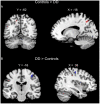Brain Mechanisms Underlying Visuo-Orthographic Deficits in Children With Developmental Dyslexia
- PMID: 30574080
- PMCID: PMC6291466
- DOI: 10.3389/fnhum.2018.00490
Brain Mechanisms Underlying Visuo-Orthographic Deficits in Children With Developmental Dyslexia
Abstract
Multiple hypotheses have been proposed to explain the reading difficulty caused by developmental dyslexia (DD). The current study examined visuo-orthographic processing in children with dyslexia to determine whether orthographic deficits are explainable based solely on visual deficits. To identify orthographic-specific, visual perception-specific, and overlapping deficits, we included two tasks (lexical and perceptual) in three Chinese subject groups: children with DD, age-matched controls (AC), and reading matched controls (RC) using functional magnetic resonance imaging (fMRI). We found that the left precuneus showed decreased activation across both tasks for the DD group compared to the two control groups, thus reflecting visual processing deficits in children with DD, which also affects orthographic processing. Furthermore, we found that the functional connectivity between left middle occipital gyrus (LMOG) and left inferior frontal gyrus (IFG) was decreased in the DD group compared to AC and RC for only the lexical task. This suggests a weaker association between orthography and phonology for children with DD. In addition, the children with DD showed decreased functional connectivity between the LMOG and right parahippocampal gyrus for only the visual perceptual task, thereby indicating a weaker association between visual regions for DD during visual symbol processing. Taken together, our findings suggest that the observed orthographic processing deficit in DD might be driven by both a basic visual deficit, and a linguistic deficit.
Keywords: PPI; dyslexia; fMRI; orthographic deficit; visual deficit.
Figures




Similar articles
-
Neural signatures of phonological deficits in Chinese developmental dyslexia.Neuroimage. 2017 Feb 1;146:301-311. doi: 10.1016/j.neuroimage.2016.11.051. Epub 2016 Nov 24. Neuroimage. 2017. PMID: 27890803
-
Structural and functional abnormality of the putamen in children with developmental dyslexia.Neuropsychologia. 2019 Jul;130:26-37. doi: 10.1016/j.neuropsychologia.2018.07.014. Epub 2018 Jul 17. Neuropsychologia. 2019. PMID: 30030195
-
Shared and task-specific brain functional differences across multiple tasks in children with developmental dyslexia.Neuropsychologia. 2024 Aug 13;201:108935. doi: 10.1016/j.neuropsychologia.2024.108935. Epub 2024 Jun 5. Neuropsychologia. 2024. PMID: 38848989
-
Perceptual learning as a possible new approach for remediation and prevention of developmental dyslexia.Vision Res. 2014 Jun;99:78-87. doi: 10.1016/j.visres.2013.11.011. Epub 2013 Dec 8. Vision Res. 2014. PMID: 24325850 Review.
-
How the visual aspects can be crucial in reading acquisition? The intriguing case of crowding and developmental dyslexia.J Vis. 2015 Jan 14;15(1):15.1.8. doi: 10.1167/15.1.8. J Vis. 2015. PMID: 25589292 Review.
Cited by
-
Distinct impact modes of polygenic disposition to dyslexia in the adult brain.Sci Adv. 2024 Dec 20;10(51):eadq2754. doi: 10.1126/sciadv.adq2754. Epub 2024 Dec 18. Sci Adv. 2024. PMID: 39693421 Free PMC article.
-
Convergent and divergent brain structural and functional abnormalities associated with developmental dyslexia.Elife. 2021 Sep 27;10:e69523. doi: 10.7554/eLife.69523. Elife. 2021. PMID: 34569931 Free PMC article.
-
Reading disability is characterized by reduced print-speech convergence.Child Dev. 2024 Nov-Dec;95(6):1982-1999. doi: 10.1111/cdev.14134. Epub 2024 Jul 20. Child Dev. 2024. PMID: 39032033 Free PMC article.
-
Children With Dyslexia and Familial Risk for Dyslexia Present Atypical Development of the Neuronal Phonological Network.Front Neurosci. 2019 Nov 29;13:1287. doi: 10.3389/fnins.2019.01287. eCollection 2019. Front Neurosci. 2019. PMID: 31849595 Free PMC article.
-
Examination of common and unique brain regions for atypical reading and math: a meta-analysis.Cereb Cortex. 2023 May 24;33(11):6959-6989. doi: 10.1093/cercor/bhad013. Cereb Cortex. 2023. PMID: 36758954 Free PMC article.
References
-
- Abutalebi J., Green D. (2007). Bilingual language production: the neurocognition of language representation and control. J. Neurolinguist. 20 242–275. 10.1016/j.jneuroling.2006.10.003 - DOI
LinkOut - more resources
Full Text Sources

